THE UNITED REPUBLIC OF TANZANIA NATIONAL EXAMINATIONS COUNCIL OF TANZANIA
CERTIFICATE OF SECONDARY EDUCATION EXAMINATION
033/1 BIOLOGY 1
(For Both School and Private Candidates)
Time: 3 Hours Year: 2023
Instructions
- This paper consists of sections A, B and C with a total of eleven (11) questions.
- Answer all the questions in the sections A and B and two (2) questions from section C.
- Section A carries sixteen (16) marks, section B fifty four (54) marks and section C carries thirty (30) marks.
- All writing should be in blue or black pen, except for diagrams that must be drawn in pencil.
- Communication devices and any unauthorised materials are not allowed in the examination room.
- Write your Examination Number on every page of your answer booklet(s).
SECTION A (16 Marks)
Answer all questions in this section.
1. For each of the item (i) - (x). choose the correct answer from the given alternatives and write its letter beside the item number in the answer booklet provided.
(i) Which theory postulates that living organisms originated from non-living organisms?
- Chemical evolution
- Cosmozoan
- Steady slate
- Special creation
- Spontaneous generation
(ii) Which part protects lungs from injury and shock?
- Trachea
- Rib
- Bronchus
- Epiglottis
- Diaphragm
(iii) A boy climbed a coconut tree to harvest coconuts. Unfortunately, he fell down and broke his upper arm. Which bone was broken?
- Ulna
- Humerus
- Radius
- Femur
- Tibia
(iv) A patient was confirmed suffering from meningitis at Maweni hospital. How can the disease be prevented from spreading?
- Eliminating fleas
- Abstaining from sex
- Isolating the patients
- Killing water snails
- Cutting long grasses
(v) If a girl had the menstruation on 12th August 2023. when would she experience the ovulation period, if she has 28 days' cycle?
- 21 September 2023
- 8th September 2023
- 20th August 2023
- 25th August 2023
- 31th August 2023
(vi) What will be the genotype of the offsprings that will be produced in the first filial generation from a cross between parents of blood group with IA IO and IB genotypes?
- IA IA, IB IB, IB IO, IA IO
- IA IA, IA IB, IA IO, IB IO
- IA IB, IO IO, IA IO, IA IA
- IB IO, IA IO, IB IB, IA IB
- IA IA, IA IO, IO IO, IB IB
(vii) Which control measure would you recommend to a patient diagnosed with diabetes mellitus'?
- Reducing intake of sugary foods
- Limiting amount of water intake
- Reducing intake of cholesterol foods
- Eating enough starch and water
- Consuming a high fat food
(viii) Which group represents only the living things?
- Dog, frog, stone and lizard
- Soil, water, mushroom and bee
- Bee, moss. mushroom and frog
- Moss, soil, mushroom and lizard
- Lizard, mushroom, water and soil
(ix) Which food chain represents the correct flow of energy in the ecosystem'?
- Hawk → Grasses→ Grasshopper→ Lizard
- Grasses→ Hawk →Lizard →Grasshopper
- Lizard→ Grasses →Grasshopper → Hawk
- Grasses →Hawk→ Grasshopper→Lizard
- Grasses→ Grasshopper→ Lizard →Hawk
(x) A blood vessel which takes away blood from the glomerulus is narrower than the blood vessel which enters blood into the glomerulus. What does it imply with respect to urine formation?
- Creates low pressure for efficient filtration of blood
- Increases surface area for selective reabsorption
- Builds up high pressure for ultra-filtration of blood
- Reduces diffusion distance (or faster filtration
- Creates high pressure for ultra-filtration of urine
THE UNITED REPUBLIC OF TANZANIA NATIONAL EXAMINATIONS COUNCIL OF TANZANIA
CERTIFICATE OF SECONDARY EDUCATION EXAMINATION
033/1 BIOLOGY 1
(For Both School and Private Candidates)
Time: 3 Hours Year: 2022
Instructions
1. This paper consists of sections A, B and C with a total of fifteen (15) questions.
2. Answer all questions in sections A and B and two (2) questions from section C of which question number 13 is compulsory.
3. Section A carries fifteen (15) marks, section B sixty (60) marks and section C carries twenty five (25) marks.
4. All writing should be in blue or black pen, except for diagrams that must be drawn in pencil.
5. Cellular phones and any unauthorised materials are not allowed in the examination room.
6. Write your Examination Number on every page of your answer booklet(s).
SECTION A (15 Marks)
Answer all questions in this section.
l . For each of the items (i) - (x), choose the correct answer from among the given alternatives and write its letter beside the item number in the answer booklet provided.
(i) Which component of the nervous system receives impulses from receptors?
- Response
- Effector
- Relay
- Motor
- Coordinator
(ii) Which of the following is the proper method for disposing plastic bottles?
- Landfill
- Incineration
- Burying
- Recycling
- Pit latrine
(iii) An individual who is riding a bicycle can waste a lot of water through sweating. Which of the following organs is responsible for the water loss?
- Stomach
- Kidney
- Skin
- Liver
- Lungs
(iv) In the cowshed, a red furred cow mates with a white furred bull. In Ft generation all cows were red furred. What does this suggest about fur colour in cow?
- Incomplete dominance
- Co-dominance
- Multiple allelism
- Complete dominance
- Partial dominance
(v) Which of the following parts allow water to enter into the seed before germination?
- Testa
- Plumule
- Radicle
- Cotyledon
- Micropyle
(vi) In natural selection, which types of characteristics are affected?
- Inherited
- Acquired
- Survived
- Dominant
- Recessive
(vii) Which process allows absorption of water and mineral salts from the soil in plants?
- Diffusion
- Osmosis
- Irritability
- Mass now
- Regulation
(viii) Why spiders and scorpions are placed in the same class?
- They have three pairs of legs
- They have a pair of wings
- They have a pair of chelicera
- They have three body parts
- They have two pairs of antennae
(ix) Straightening and bending of the arm involve contraction of the biceps and triceps muscles. Which of the following alternatives describes the state of muscles when human arm is bent?
- Biceps muscles contract while triceps relax
- Triceps muscles contract while biceps relax
- Both the biceps and triceps muscles relax
- Biceps muscles relax while triceps contract
- Both biceps and triceps muscles contract
(x) Which features are found in both plant and animal cells?
- Chloroplast, cell wall and cell membrane
- Cell membrane, nucleus and cytoplasm
- Vacuole, cell membrane and cell wall
- Cell wall, chloroplast and vacuole
- Chloroplast, nucleus and cell wall
THE UNITED REPUBLIC OF TANZANIA NATIONAL EXAMINATIONS COUNCIL OF TANZANIA
CERTIFICATE OF SECONDARY EDUCATION EXAMINATION
033/1 BIOLOGY 1
(For Both School and Private Candidates)
Time: 3 Hours Year: 2021
Instructions
- This paper consists of sections A, B and C with a total of fifteen (15) questions.
- Answer all the questions in sections A and B and two (2) questions from section C of which question number 13 is compulsory.
- Section A carries fifteen (15) marks, section B sixty (60) marks and section C carries twenty five (25) marks.
- All writing should be in blue or black pen, except for diagrams that must be drawn in pencil.
- Cellular phones and any unauthorised materials are not allowed in the examination room.
- Write your Examination Number on every page of your answer booklet(s).
SECTION A (15 Marks)
Answer all questions in this section.
I For each of the items (i) - (x), choose the correct answer from among the given alternatives and write its letter beside the item number in the answer booklet provided.
(i) Which respiratory surface is used for gaseous exchange in tadpoles?
- Spiracles
- Gills
- Lungs
- Skin
- Book lung
(ii) Which of the following apparatuses are used for magnifying specimens?
- Hand lens and petri dish
- Hand lens and watch glass
- Microscope and watch glass
- Microscope and hand lens
- Measuring cylinder and beaker
(iii) Which safety precaution should be taken when administering First Aid to a wounded person?
- Washing hands with soap
- Wearing protective gloves
- Calling the ambulance for pick-up
- Washing the wound with soap
- Drying the wound with clean cloth
(iv) The following are the characteristics of prokaryotes except
- have nuclear materials.
- they are microscopic.
- have nuclear membrane.
- have cell wall.
- they are single celled organisms.
(v) Which of the following are the end products of digestion when lipids are digested completely?
- Glucose and fructose
- Fatty acids and glucose
- Amino acids and fructose
- Glucose and glycerol
- Fatty acids and glycerol
(vi) What happens when a person moves from a bright lighted to a dim lighted room?
- Pupil becomes large
- Pupil becomes small
- Circular muscles contract
- Radial muscles relax
- Radial and circular muscles relax
(vii) Which of the following set of conditions is necessary for seed germination?
- Temperature, soil and water
- Water and carbon dioxide
- Water, temperature and oxygen
- Water, temperature and food
- Soil, oxygen and water
(viii) The laboratory technician investigated the faeces of a patient and found organisms with flattened segmented bodies. What is the name of the organisms?
- Tapeworms
- Roundworms
- Liver flukes
- Filarial worms
- Planaria
(ix)The following balanced habitat contains grasses, wildebeests, lions and bacteria. What would happen if lions were removed?
- The number of bacteria would remain the same.
- The number of wildebeest would decrease.
- The amount of grasses would decrease.
- The amount of grasses would increase.
- The number of wildebeests would increase.
(x)What will happen if phloem tissue is destroyed in green plants?
- Absorption of water in the plant body will stop.
- Absorption of mineral salts will stop.
- Transport of water and manufactured food will stop.
- Transport of manufactured food will stop.
- Transport of oxygen in the plant body will stop.
THE UNITED REPUBLIC OF TANZANIA NATIONAL EXANIINATIONS COUNCIL OF TANZANIA
CERTIFICATE OF SECONDARY EDUCATION EXAMINATION
033/1 BIOLOGY 1
(For Both School and Private Candidates)
Time: 3 Hours Year: 2020
Instructions
l . This paper consists of sections A, B and C with a total of fifteen (15) questions.
2.Answer all the questions in the sections A and B and two (2) questions from section C of which question 13 is compulsory.
3.Section A carries fifteen (15) marks, section B sixty (60) marks and section C carries twenty five (25) marks.
4.All writing should be in blue or black pen, except for diagrams that must be drawn in pencil.
5.Cellular phones and any unauthorized materials are not allowed in the examination room.
6.Write your Examination Number on every page of your answer booklet(s).
SECTION A (15 Marks)
Answer all questions in this section.
For each of the items (i) - (x), choose the correct answer from among the given alternatives and write its letter beside the item number in the answer booklet provided.
(i)What is the main product of anaerobic respiration in plants?
- Uric acid
- Lactic acid
- Water
- Alcohol
- Pyruvic acid
(ii)Suppose you are provided with small sections of cells from different organisms, which equipment will you use to identify them?
- Test tube
- Watch glass
- Microscope
- Petri dish
- Beaker
(iii) In which Phylum do filarial worms belong?
- Annelida
- Nematoda
- Arthopoda
- Platyhelminthes
- Chordata
(iv)Which nutritional disorder may result when a person takes larger quantities of carbohydrate than body's requirements?
- Rickets
- Marasmus
- Beriberi
- Kwashiorkor
- Obesity
(v)What is the role of the cerebrum in human beings?
- Breathing
- Sneezing
- Yawning
- Learning
- Walking
(vi)In which specific part of the female reproductive system is tubal ligation applied as a method of birth control?
- Oviduct
- Uterus
- Cervix
- Ovary
- Vagina
(vii)Why a faint victim should be laid down with the head lower than the feet when rendering First Aid?
- The body needs minerals
- The brain needs oxygenated blood
- The body needs nutrients
- The lung needs deoxygenated blood
- The victim needs carbon dioxide
(viii)Which of the following structures of organisms are homologous?
- Wings of birds and wings of grasshoppers
- Forelimbs of man and wings of butterfly
- Wings of houseflies and wings of bat
- Wings of bees and forelimbs of man
- Forelimbs of man and wings of bat
(ix)Why is transfusion of blood from a donor with group O to a recipient with blood group AB successful?
- The recipient's blood has no antibodies.
- The recipient's blood has no antigens.
- The donor's blood has many antigens.
- The donor's blood has many antibodies.
- The recipient's blood has antigen O.
(x)Study the following groups of organs and answer the question that follows:
(i)Tongue, stomach, liver and the intestine.
(ii)Stomach, tongue, heart and liver.
(iii)Urethra, urinary bladder, ureter and kidney.
(iv)Urinary bladder, kidney, tongue and heart.
Which combination forms a system?
- (i) and (ii)
- (i) and (iv)
- (i) and (iii)
- (ii) and (iv)
- (ii) and (iii)
THE UNITED REPUBLIC OF TANZANIA NATIONAL EXAMINATIONS COUNCIL OF TANZANIA
CERTIFICATE OF SECONDARY EDUCATION EXAMINATION
033/1 BIOLOGY 1
(For Both School and Private Candidates)
Time: 3 Hours Tuesday, 05th November 2019 a.m.
Instructions
- This paper consists of sections A, B and C with a total of fifteen (15) questions.
- Answer all the questions in sections A and B and two (2) questions from section C of which question 13 is compulsory.
- All writing should be in blue or black pen, except for diagrams that must be drawn in pencil.
- Cellular phones and any unauthorised materials are not allowed in the examination room.
- Write your Examination Number on every page of your answer booklet(s).
SECTION A (15 Marks)
Answer all questions in this section.
1 For each of the items (i) - (x), choose the correct answer from among the given alternatives and write its letter beside the item number in the answer booklet provided.
(i) What is the aim of doing experiment when conducting a scientific investigation?
- Identifying a problem
- Finding a solution
- Testing a hypothesis
- Gathering information
- Recording results
(ii) Why is it advised to build an incinerator in every hospital and health centre?
- for collecting wastes.
- for disposing gaseous wastes.
- for disposing liquid wastes.
- for burning hazardous wastes.
- for disposing plastic wastes.
(iii) Mrs. Jumas child has protruding stomach and swollen lower limbs. What type of food should she give to her child to overcome the problem?
- Starch
- Lipids
- Proteins
- Minerals
- Vitamins
(iv) In the food chain: Grass  Lion. A lion is:
Lion. A lion is:
- a primary consumer.
- a secondary consumer.
- a producer.
- a tertiary consumer.
- a decomposer.
(v) Water from the roots of flowering plants is transported up to the plant by different forces. Which of the following forces initiates and raises water to the least height?
- Root pressure
- Transpiration pull
- Cohesion forces
- Adhesion forces
- Capillarity
(vi) A patient has been diagnosed with low level of blood sugar. Which hormone would you recommend to regulate the victims sugar?
- Insulin
- Glucagon
- Antidiuretic
- Aldosterone
- Testosterone
(vii) Which one is the feature of aging in human beings?
- Shorter reaction times
- Strong bones
- Strong muscles
- Body increases in size
- Wrinkling of the skin
(viii) What is the role of node of ranvier in a neurone?
- To transmit the impulses away from the cell body.
- To insulate the axon and speed up transmission of impulses.
- To transmit nerve impulses from one nerve to another.
- To speed up the transmission of nerve impulses.
- To transmit the nerve impulses towards the cell body.
(ix) What is variation as applied to genetics?
- Differences among individuals of the related species.
- Differences among individuals of the same species.
- Differences among individuals of different species.
- Differences among individuals of unrelated species.
- Differences among individuals of the expected species.
(x) Which one is correct about Cosmozian theory of origin of life?
- Life was brought in this Earth from elsewhere.
- Life arose according to physical and chemical laws.
- Living organisms arose from non-living materials.
- The Earth and all the organisms on it were created by God.
- The planet Earth and all the organisms have always been there.
THE UNITED REPUBLIC OF TANZANIA NATIONAL EXAMINATIONS COUNCIL OF TANZANIA
CERTIFICATE OF SECONDARY EDUCATION EXAMINATION
033/1 BIOLOGY 1 (For Both School and Private Candidates)
Time: 3 Hours Wednesday, 07th November 2018 a.m.
Instructions
-
This paper consists of sections A, B and C with a total of thirteen (13) questions.
-
Answer all questions in sections A and B and one (1) question from section C.
-
Except for diagrams that must be drawn in pencil, all writing should be in blue or black ink.
-
Calculators, cellular phones and any unauthorized materials are not allowed in the examination room.
-
Write your Examination Number on every page of your answer booklet(s).
SECTION A (20 Marks)
Answer all questions in this section.
For each of the items (i) - (x), choose the correct answer from among the given alternatives and write its letter beside the item number in the answer booklet.
(i) Mitosis normally takes place in
- reproductive cells
- animal cells only
- blood plasma
- plant cells only
- somatic cells.
(ii) Which of the following is the symptom of the disease caused by lack of protein in children?
- Anemia
- Swollen head
- Breeding
- Pale and thin hair
- Sneezing.
(iii) flow many gametes are produced from one cell during meiosis?
- Eight
- Two
- Four
- Six
- Ten.
(iv) Which of the following is the excretory organ in human?
- Mouth
- Kidney
- Pancreas
- Stomach
- Anus.
(v) Which of the following hormones stimulates seed germination in plants?
- Gibberellins
- Auxin
- Cytokinins
- Abscisic acid
- Ethene.
(vi) A joint which allows rotation in all planes is called
- suture
- ball and socket
- pivot
- ligament
- hinge.
(vii) In which environmental condition the loss of water vapour from plants is mostly favourable?
- Hot and Windy day
- A saturated atmosphere
- Cool and dry atmosphere
- Windy day
- Hot day.
(viii) The function of the bright coloured petals in flowers is
- to store nectarines
- to hold sepals in position
- to produce colour of the flower
- to receive pollen grain
- to attract insects for pollination.
(ix) The function of hydrochloric acid in food testing experiment is
- to decolourise food sample
- to test reducing sugar
- to oxidize the food sample
- to neutralize sugary foods
- to hydrolyze complex to simple sugar.
(x) The interaction between two species in which both organisms benefit is known as
- ectoparasite
- parasitism
- commensalisms
- mutualism
- endoparasite.
THE UNITED REPUBLIC OF TANZANIA NATIONAL EXAMINATIONS COUNCIL
CERTIFICATE OF SECONDARY EDUCATION EXAMINATION
033/1 BIOLOGY 1
(For Both School and Private Candidates)
Time: 3 Hours Wednesday, 01stNovember 2017 a.m.
Instructions
- This paper consists of sections A, B and C with a total of thirteen (13) questions.
- Answer all questions in sections A and B and one (1) question from section C.
- Except for diagrams that must be drawn in pencil, all writing should be in blue or black ink.
- Calculators, cellular phones and any unauthorised materials are not allowed in the examination room.
- Write your Examination Number on every page of your answer booklet(s).
SECTION A (20 Marks)
Answer all questions in this section.
1. For each of the items (i) - (x), choose the correct answer among the given alternatives and write its letter beside the item number in the answer booklet provided.
(i) Goitre is a deficiency disease caused by lack of which element in the diet?
- Carbohydrate
- Iodine
- Vitamin E
- Vitamin C
- Protein.
(ii) Tongue rollers in genetics is an example of
- gametogenesis
- continuous variation
- swallowing
- lubricating food
- discontinuous variation.
(iii)Which food substance is investigated in the biuret test procedur?
- Carbohydrate
- Lipids
- Protein
- Starch
- Reducing sugar.
(iv) The product of anaerobic respiration process in animals is
- lactic acid
- carbondioxide
- alcohol
- water
- oxygen.
(v) A phylum consisting of species with jointed appendages and exoskeleton is known as
- Chordata
- Anelida
- Arthropoda
- Platyhelminthesis
- Nematoda.
(vi) Which part of the flower receives pollen grain during pollination?
- Petal
- Stigma
- Stamen
- Style
- Ovary.
(vii) A rapid growth in plants is mainly taking place in
- leaves
- cambium
- roots
- shoots and root tips
- stem.
(viii) Which of the following is NOT a component of First Aid Kit?
- Razor blade
- Panadol
- Bandage
- Soap
- Microscope.
(ix) Which disease spread rapidly as a result of poor waste disposal?
- Anemia
- AIDS
- Cholera
- Leukemia
- Small pox.
(x) A voluntary muscle that is capable of relaxing continuously and do not fatigue easily is known as
- skeletal muscle
- biceps
- triceps
- cardiac muscle
- smooth muscle.
THE UNITED REPUBLIC OF TANZANIA NATIONAL EXAMINATIONS COUNCIL
CERTIFICATE OF SECONDARY EDUCATION EXAMINATION
033/1 BIOLOGY 1
(For Both School and Private Candidates)
Time: 3 Hours Thursday, 03 rd November 2016 a.m.
Instructions
-
This paper consists of sections A, B and C.
-
Answer all questions in sections A and B and one (1) question from section C.
-
Except for diagrams that must be drawn in pencil, all writings should be in blue or black ink.
-
Calculators and cellular phones are not allowed in the examination room.
-
Write your Examination Number on every page of your answer booklet(s).
SECTION A (20 Marks)
Answer all questions in this section.
-
For each of the items (i) - (x), choose the correct answer among the given alternatives and write its letter beside the item number in the answer booklet provided.
(i)Caridac muscle can be found in which part of the animal body?
- Skull
- Heart
- Small intestine
- Limbs
- Head.
(ii)The kidney in animals is mainly responsible for
- excretion
- digestion
- transportation
- respiration
- absorption.
(iii) The aim of experiment in the scientific investigation is to
- identify the problem
- test the hypothesis
- confirm the problem
- predict the results
- collect data.
(iv) The main product of anaerobic respiration process in plants is
- uric acid
- lactic acid
- alcohol
- water
- oxygen.
(v) Which of the following parasitic organisms is typicall ectoparasite?
- Tick
- Tapeworm
- Plasmodium
- Round worm
- Lichen.
(vi) Which of the following is a seed bearing plant?
- Liverwort
- Prothallus
- Fern
- Sisal
- Moses.
(vii) A part of an onion bulb which is important for vegetative propagation is
- scale leaves
- foliage leaves
- terminal buds
- roots
- stem.
(viii) Which of the following is NOT a component of blood?
- Erythrocyte
- Platelets
- Leucocyte
- Plasma
- Vein.
(x) Which food substance can be tested by using iodine solution?
- Protein
- Starch
- Carbohydrate
- Non reducing sugar
- Reducing sugar.
(x) The offspring produced by mating the F1 generation is konwn as
- F3 generation
- F1 products
- F2 generation
- New generation
- Genetic generation.
THE UNITED REPUBLIC OF TANZANIA NATIONAL EXAMINATIONS COUNCIL
CERTIFICATE OF SECONDARY EDUCATION EXAMINATION
033/1 BIOLOGY 1
(For Both School and Private Candidates)
TIME: 3 HOURS Wednesday, 04 th November 2015 a.m.
INSTRUCTIONS
-
This paper consists of three sections A, B and C.
-
Answer all questions from sections A and B and one (1) question from section C.
-
Except for diagrams that must be drawn in pencil, all writing should be done using a blue or black pen.
-
Calculators and cellular phones are not allowed in the examination room.
-
Write your Examination Number on every page of your answer booklet(s).
SECTION A (20 MARKS)
Answer all questions in this section.
1. For each of the items (i) – (x), choose the correct answer from among the given alternatives and write its letter beside the item number in the answer booklet provided.
(i) Bowmans capsule is found in which of the following organs?
- Liver
- Pancreas
- Kidney
- Spleen
- Heart
(ii) Which of the following processes is involved in the regulation of body temperature in human beings?
- Urination
- Painting
- Deamination
- Sweating
- Detoxification
(iii) A structure that allows air to enter the trachea and prevents food from entering the wind pipe is known as
- glottis
- tongue
- soft plate
- mouth
- epiglottis
(iv) Study the following sequence of organisms: Grass ? Rabbit ? Wolves ? Fleas
The sequence is an example of
- food web
- ecosystem
- a pyramid
- food chain
- abiotic
(v) Lipase enzymes are mainly contained in which digestive secretions?
- Hydrochloric acid
- Gastric juice
- Saliva
- Intestinal juice
- Pancreatic juice
(vi) A person who is admitted in the hospital after an operation will most likely be fed on food rich in:
- vitamin C
- vitamin A
- protein
- lipids
- water
(vi) Which of the following is a vector of sleeping sickness?
- House fly
- Mosquito
- Tsetse-fly
- Tick
- Cockroach
(vii) The outer most living structure that identifies a plant cell is the presence of
- cytoplasm
- vacuole
- cell wall
- nuclear membrane
- cell membrane
(x) One of the most distinctive features used to place organisms in the Kingdom Fungi is the presence of
- gill structures
- hyphae
- cellulose
- cap
- exoskeleton
(x) Which of the following represent the organisms with homologous structures?
- Wings of Birds and Butterfly
- Forelimbs of Bird and Bat
- Tail of Rat and Scorpion
- Sting of Honey bee and Mosquito
- Beak of Duck and Hen
THE UNITED REPUBLIC OF TANZANIA NATIONAL EXAMINATIONS COUNCIL
CERTIFICATE OF SECONDARY EDUCATION EXAMINATION
033/1 BIOLOGY 1
(For Both School and Private Candidates)
TIME: 3 HOURS Wednesday, 05 th November 2014 a.m.
INSTRUCTIONS
-
This paper consists of three sections A, B and C.
-
Answer all questions from sections A and B and one (1) question from section C.
-
Except for diagrams that must be drawn in pencil, all writings should be in blue or black ink.
-
Calculators and cellular phones are not allowed in the examination room.
-
Write your Examination Number on every page of your answer booklet(s).
SECTION A (20 MARKS)
Answer all questions in this section.
1.. For each of the items (i) – (x), choose the correct answer from among the given alternatives and write its letter beside the item number in your answer booklet.
(i)A term which best describes a condition of a plant cell that has lost too much water is
- haemolysis
- turgidity
- creanation
- plasmolysis
- osmosis
(ii) Bowmans capsule in the kidney functions as a
- filter
- sanction
- transmitter
- sponge pump
- absorber
(iii) A structure which controls the body balance in humans is located in the
- outer ear
- eardrum
- inner ear
- middle ear
- inner membrane
(iv) The main product of photosynthesis process is
- sunlight
- carbohydrate energy
- carbon dioxide
- water
- oxygen
(v) Species with cellulose in their cells are formally placed in
- Kingdom Monera
- Kingdom Animalia
- Kingdom Fungi
- Kingdom Plantae
- Kingdom Protista
(vi) Fertilization process is defined as
- formation of new cells
- union of an egg and sperm
- implantation of a zygote
- fusion of eggs in the uterus
- cell division in the oviduct
(vii) Mutual interaction between two species is described by which of the following characteristic
- Both live as parasite
- Both may be harmed
- Both benefit and flourish
- One is harmed and the other benefits
- Both neither benefits for is harmed
(viii) One of the characteristics used to identify producers in the ecosystem is
- feeding on ready-made food
- growing in fertile soil
- feeding on other organisms
- making their own food
- adding organic matter in the soil
(ix) The role of the optimum temperature in cellular activities is to
- change the chemical reactions
- balance the equilibrium of the reactions
- destroy many enzymes at once
- speed up the rate of chemical reaction
- create favourable environment for enzymes
(x) Rise of body temperature in the human body is corrected mainly by
- Dilating the skin arteries and sweating
- Constricting the skin arteries and shivering
- Dilating the skin veins and sweating
- Constricting the skin veins and shivering
- Dilating of arteries and shivering
THE UNITED REPUBLIC OF TANZANIA NATIONAL EXAMINATIONS COUNCIL
CERTIFICATE OF SECONDARY EDUCATION EXAMINATION
033/1 BIOLOGY 1
(For School Candidates Only)
TIME: 3 HOURS Thursday, 07 th November 2013 a.m.
INSTRUCTIONS
-
This paper consists of three sections A, B and C.
-
Answer all questions from sections A and B and one (1) question from section C.
-
Except for diagrams that must be drawn in pencil, all writing should be done using a blue or black pen.
-
Calculators and cellular phones are not allowed in the examination room.
-
Write your Examination Number on every page of your answer booklet(s).
SECTION A (20 MARKS)
1. For each of the items (i) – (x), choose the correct answer from among the given alternatives and write its letter beside the item number.
(i) Animals which are able to maintain fairly constant body temperature are described as
- poikilothermic
- hydrostatic
- sympathetic
- symbiotic
- homoiothermic
(ii) Night blindness in the human body is avoided by eating
- oranges
- carrot
- red
- green vegetables meat
- chicken
(iii) A blood vessel which conveys deoxygenated blood away from the heart is called
- capillaries
- artery
- vein
- pulmonary vein
- pulmonary artery
(iv) The function of cones in the human eye is to
- sense light
- sense colour
- cover the eye
- reflect light
- protect the eye
(v) A term used to identify an individual animal having both male and female sex organs is
- unisexual
- hermaphrodite
- asexual
- dioecious
- monoecious
(vi) Which of the following structures is a site of respiration?
- Chloroplast
- Ribosome
- Nuclear
- Nucleic acid
- Mitochondrion
(vii) The structures found in bacteria are A plasmid, flagella and cilia
- cytoplasm, cilia and pastids
- cell wall, plasmid and flagella
- cell membrane,
- flagella and hairs
- plasmid, capsule and cilia
(viii) The by products in the photosynthesis process are
- carbohydrate and water
- carbon dioxide and oxygen
- oxygen and water
- carbohydrate and carbon dioxide
- oxygen and air
(ix) The factors which contribute to the spread of dental cavities in human being include
- prolonged exposure to cold water
- prolonged exposure
- prolonged exposure to warm water
- prolonged exposure to bitter food to hard water
- prolonged exposure to sugary foodstuff
(x) The main feature observed in prokaryotic is that they
- have genetic materials not enclosed by nuclear membrane
- have genetic material enclosed by nuclear membrane
- have no genetic material in their nuclear
- have more than one nucleic acid in their nuclear
- have genetic material enclosed by two membranes
THE UNITED REPUBLIC OF TANZANIA NATIONAL EXAMINATIONS COUNCIL
CERTIFICATE OF SECONDARY EDUCATION EXAMINATION 033/1 BIOLOGY 1
TIME: 3 HOURS Thursday, 11 th October 2012a.m.
INSTRUCTIONS
-
This paper consists of three sections A, B and C.
-
Answer all questions from sections A and B and one (1) question from section C.
-
Read each question carefully before you start answering it.
-
Except for diagrams that must be drawn in pencil, all writing should be done using a blue or black pen.
-
Calculators are not allowed in the examination room.
-
Cellular phones are not allowed in the examination room.
-
Write your Examination Number on every page of your answer booklet(s).
SECTION A (20 MARKS)
1. For each of the items (i) – (x), choose the correct answer from among the given alternatives and write its letter beside the item number.
(i)The joint in the human body which allows movement in all directions is known as
- pivot
- hinge
- double hinge
- ball
- peg and socket and socket
(ii)Which of the following is a metabolic waste product?
- Tears
- Saliva
- Mucus
- Faeces
- Urine
(iii) The following are examples of water-borne diseases:
- malaria and bilharzia
- yellow fever and typhoid
- diarrhoea and malaria
- cholera and plaque
- cholera and typhoid
(iv)One of the distinctive features of kingdom Fungi is possession of:
- plasma membrane
- cytoplasm
- chitin materials
- cell membrane
- cellulose material
(v)The regions of most active growth in plants are found mainly in the
- axillary buds and flowered
- stems and leaves
- stems and root hairs
- leaves and flowers
- stem and root apices
(vi) A grasshopper ventilates its gaseous exchange surfaces by
- moving the diaphragm
- beating of cilia
- rhythmic body movement
- opening of spiracles
- moving its rib cage
(vii) The taxonomic category of organisms belonging to the same class but not the same family is:
- Species
- Genus
- Order
- Phylum
- Kingdom
(viii) The breakdown of glycogen into glucose in the body is due to the action of:
- insulin
- adrenaline
- secretion
- glucagon
- gastric
(ix) The function of sunlight energy in the human skin is the stimulate the synthesis of
- vitamin A
- vitamin C
- vitamin D
- vitamin K
- vitamin B
(x)A rise in the temperature of a human body is corrected by
- construction of the skin arteries and sweating
- construction of the skin arteries and shivering
- dilation of the skin arteries and sweating
- dilation of the skin arteries and shivering
- shivering and sweating
THE UNITED REPUBLIC OF TANZANIA NATIONAL EXAMINATIONS COUNCIL
CERTIFICATE OF SECONDARY EDUCATION EXAMINATION 033/1 BIOLOGY 1
TIME: 3 HOURS Wednesday, 05 th October 2011 a.m.
INSTRUCTIONS
-
This paper consists of three sections A, B and C.
-
Answer all questions from sections A and B and one (1) question from section C.
-
Read each question carefully before you start answering it.
-
Except for diagrams that must be drawn in pencil, all writings should be in blue/black ink or ball point pen.
-
Calculators are not allowed in the examination room.
-
Cellular phones are not allowed in the examination room.
-
Write your Examination Number on every page of your answer booklet(s).
SECTION A (20 MARKS)
Answer all questions in this section, each question carries 10 marks.
1. For each of the items (i) – (x) choose the correct answer from among the given alternatives and write its letter beside the item number.
(i) How many gametes are produced from one cell during meiosis?
- Two
- Four
- Six
- Eight
- Ten
(ii) Which of the following is not an excretory product in plants?
- Tannins
- Carbon Dioxide
- Urea
- Calcium oxalate
- Latex
(iii) Why are skeletal muscles usually found in opposing pairs?
- One muscle alone cannot extend a joint
- Muscles can only work by contraction
- One muscle alone cannot flex a joint
- Paired muscles are stronger
- Muscles normally work in antagonistic fashion
(iv) Which of the following bests defines allergy?
- Body reaction to antigen
- Body reaction against a specific drug
- Body reaction against a diseasecausing microorganism
- Accumulation of mucus caused by inhaling dust particles
- Formation of rash caused by eating specific foods
(v) When students were conducting private study at night, lights went off completely. Which of the following changes occurred in the eyes of the students?
- The lens became thicker
- The pupil became larger
- The ciliary muscle relaxed
- The lids close
- The eyes opened wider
(vi) Select the item that indicates the best match in vitamindeficiency:
- Vitamin A dry scaly skin
- Vitamin B loss of appetite and yawning
- Vitamin C anemia and high blood pressure
- Vitamin D soft deformed bones
- Vitamin K poor night vision
(vii) Which of the following is formed immediately after fertilization?
- Placenta
- An embryo
- A foetus
- Amniotic fluid
- A zygote
(viii) The human ovary secretes hormones known as:
- Oestrogen and testosterone
- Progesterone and testosterone
- Oestrogen and lactogen
- Oestrogen and progesterone
- Follicle stimulating hormone and progesterone
(ix) The offspring of crosses between red flowered and white flowered plants were always found to be pink. This is an example of:
- Crossing over
- Mutation
- Co-dominance
- Incomplete dominance
- Natural selection
(x) At early stages of development of the human zygote which organ develops first?
- Liver
- Heart
- Kidney
- Eyes
- Notochord
(i) Which of the following is common to both plants and animals?
- Respiration
- Digestion
- An excretory system
- Chloroplasts
- Starch grains
(ii) A flower which possesses both stamens and carpels is said to be
- Unisexual
- Hermaphrodite
- Monoecious
- Zygomorphic
- Polymorphic
(iii) Useful substances are retained in the kidney by
- Filtration
- Osmosis
- Selective reabsorption
- Osmo-regulation
- Diffusion
(iv) The Monera are also referred to as Prokaryotes. This means having:
- No nucleus
- Membrane bounded organelles
- Simple structures
- Reduced nucleus
- Circular nucleus
(v) Which of the following is a characteristic of wind-pollinated flowers?
- They have large brightly coloured petals
- They produce a small number of pollen grains
- They have small anthers situated inside the flowers
- They do not have nectarines
- They have large, sticky or spiky pollen grains
(vi) Food is moved along the oesophagus by a process known as:
- Assimilation
- Chewing
- Egestion
- Peristalsis
- Churning
(vii) Reptiles differ from birds because:
- Reptiles do not lay eggs while birds do
- Reptiles have a backbone while birds do not
- Reptiles have scales while birds do not
- Reptiles are cold blooded while birds are warm blooded
- Reptiles have moist skin while birds have dry skin
(viii) Removal of predators in the ecosystem will result in:
- Decrease in the number of producers
- Increase in the number of producers
- Decrease in the number of prey
- An increase in the number of decomposers
- No significant change
(ix) A bean plant can either bear terminal or axial flowers. When a terminal flowered plant (T) is pollinated with an axial flowered plant (t), the offspring produced were 200 terminal flowered and 210 axial flowered. Which of the following represents the genotypes of the parents?
- TT x Tt
- Tt x Tt
- TT x tt
- Tt x tt
- T x t
(x) What does selective breeding mean?
- Only pure stock should be inbred
- The parents are chosen to produce desired offspring
- The encouragement of out breeding
- The parents are chosen carefully
- The offspring are like parents
THE UNITED REPUBLIC OF TANZANIA NATIONAL EXAMINATIONS COUNCIL OF TANZANIA CERTIFICATE OF SECONDARY EDUCATION EXAMINATION
BIOLOGY
(For Both School and Private Candidates)
Time: 3 Hours Year: 2009
SECTION A
1. For each of the items (i) — (x) choose the correct answer from among the given alternatives and write its letter beside the item number.
(i)The elements carbon, nitrogen, oxygen and hydrogen would be found in:
- Amino acids
- Nitrates
- Fats
- Starch
- Vitamins
(ii)Which of the following are parasitic eukaryotic organisms?
- Amoeba and paramecium
- Euglena and green algae
- Trypanosome and plasmodium
- Brown algae and amoeba
- Plasmodium and amoeba
(iii)The outer most living structure in plant cells is the:
- Cell wall
- Cytoplasm
- Cell membrane
- Nuclear membrane
- Ectoplasm
(iv)The part of cassava plant which is modified for food storage is:
- an underground stem
- an underground root
- a corn
- a prop root
- an underground stalk
(v)The phylum chordate includes all animals that have:
- Mammary glands
- Post anal tail
- a backbone
- Scales
- Warm dry skin
(vi)Which of the following soil types has the highest water holding capacity'
- Sandy soil
- Loamy soil
- Clay soil
- Silty soil
- Sandy loam soil
(vii)The human body can make one o€the following vitamins for itself:
- Vitamin A
- Vitamin B
- Vitamin K
- Vitamin D
- Vitamin E
(viii) Examples of diseases caused by bacteria are:
- Tuberculosis, cholera and gonorrhea
- Malaria, bilharzias and cancer
- Elephantiasis, AIDS and sleeping sickness
- Measles, amoebic dysentery and chickenpox
- Common cold, Typhoid and Cholera
(ix)A colour blind woman marries a man with normal vision. What percentage of colour blind and normal children would be expected from such a marriage?
- 100% colour blind
- 75% colour blind and 25% normal
- 50% colour blind and 50% normal
- 25% colour blind and 75% normal
- 100% normal
(x) In a motor accident, the bus driver found that he could hardly maintain his body equilibrium. Which of the structures was damaged?
- Semi circular canals
- The medulla oblongata
- Pituitary gland
- The cerebellum
- The cochlea
THE UNITED REPUBLIC OF TANZANIA NATIONAL EXAMINATIONS COUNCIL OF TANZANIA CERTIFICATE OF SECONDARY EDUCATION EXAMINATION
BIOLOGY
(For Both School and Private Candidates)
Time: 3 Hours Year: 2008
SECTION A
1. For each of the following items (i) — (x) choose the correct answer among the given alternatives and write its letter beside the item number.
(i) When examining a cell from an unidentified organ of a mouse under an electron microscope, a student found an organelle with infolding in the inner membrane. Which organelle is it?
- Golgi body
- Endoplasmic reticulum
- Ribosome
- Mitochondrion
- Nucleus
(ii)Which of the following statements is true about eukaryotic cells?
- They lack important organelles like smooth endoplasmic reticulum.
- They are found in plants only.
- Nuclear materials are enclosed within a membrane.
- They are found only in animals.
- They contain only little water.
(iii)Spitting, coughing and sneezing into a tissue paper are considered as:
- Waste disposal methods
- Risk behaviors of spreading diseases
- Good manners
- Environmental pollution
- A way of killing pathogens in the tissue.
(iv) Mr. and Mrs. Msakanjia, happened to have four children in their marriage. One of them is an albino. What is the possible genotype of Mr. and Mrs. Msakanjia?
- AA x AA
- Aa x aa
- Aa x Aa
- aa x aa
- AA x Aa
(v) A mountaineer develops headache, breathlessness, nausea and vomiting on reaching an altitude of above 4000 metres. This is because:
- his body system is not given time to adjust to the low oxygen pressure.
- the atmospheric pressure as well as the supply of oxygen decreases at higher altitude.
- the increase in the amount of oxygen results into breåthlessness.
- the atmospheric pressure increases at higher altitude and so does the supply of oxygen.
- his body system is not given time to relax due to the increase of atmospheric pressure.
(vi) A student planted some seeds in sand. After the radical was fully developed, it was observed that in all seedlings it grew downward horizontally instead of vertically. This indicates that:
- the sand contained water on one side only.
- the sand contained large particles which prevented the radical to grow vertically.
- the force of gravity forced the radical to grow horizontally.
- it is the nature of radical to grow horizontally always.
- the concentration of auxin inhibited the radical to grow vertically.
(vii) During the school race Mary experienced an increased rate in breathing.
This is because breathing rate supplies extra:
- energy required by the active muscle.
- oxygen required by the active muscle.
- heat required by the active muscle.
- enzymes required by the active muscles for respiration.
- Work required by the muscles for faster running.
(viii)The best way of preventing viral infection is:
- through biological control.
- avoiding direct contact with an infected person.
- killing all viruses.
- vaccination.
- by medical treatment.
(ix)Girls circumcision or female genital mutilation is considered to be a:
- good sexual health practice because it controls prostitution among women.
- good mental health practice.
- bad physical harassment to women.
- bad practice which interferes with sexual health.
- good practice which prevents spread of HIV/AIDS.
(x)In green grass there are usually large numbers of green grasshoppers than brown grasshoppers. The best explanation is that the:
- green grasshoppers feel the need of being green to give them protection.
- predators do not capture green grasshoppers as frequently as brown grasshoppers.
- green grass makes the brown grasshopper not to be seen by the predators.
- green grasshoppers obtain enough food from green grass than brown grasshopper.
- green grass stimulates green grsshoppers to reproduce and increase in number faster than brown grasshoppers.
THE UNITED REPUBLIC OF TANZANIA NATIONAL EXAMINATIONS COUNCIL OF TANZANIA CERTIFICATE OF SECONDARY EDUCATION EXAMINATION
BIOLOGY
(For Both School and Private Candidates)
Time: 3 Hours Year: 2003
SECTION A
1. For each item (i) - (x) choose the correct answer from among the given alternatives and write its letter beside the item number.
(i)An experiment usually tests:
- application
- hypothesis
- method
- data
- evaluation
(ii) Figure 1 shows a palisade cell.
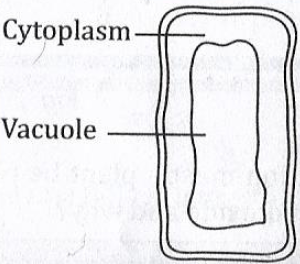 |
| Fig. 1 |
What structures occur in the regions indicated?
| In the cytoplasm | In the vacuole | |
| A. | Chloroplasts | Nucleus |
| B. | Chloroplasts and nucleus | Sap |
| C. | Nucleus | Chloroplasts |
| D. | Sap | Chloroplasts and nucleus |
| E. | Nucleus and sap | Chloroplasts |
(iii) Which substance in tobacco combines with haemoglobin to prevent the haemoglobin from carrying oxygen?
- Carbon dioxide
- Carbon monoxide
- Nicotine
- Tar
- Cellulose fibre
(iv) A plant with variegated leaves was completely destarched by p acing It in a dark cupboard for 48 hours. Black paper was then fixed on one leaf as shown in Figure 2 below and the plant was exposed to the light. After 24 hours which region of the leaf contained starch?
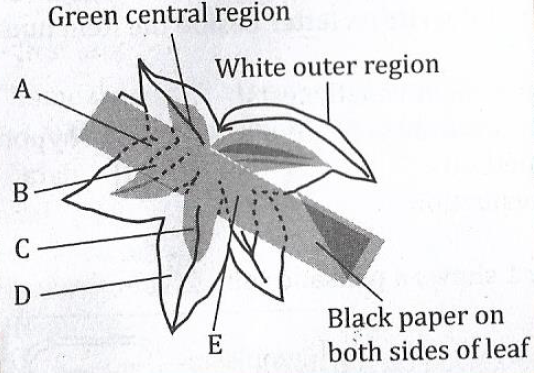 |
| Fig. 2 |
In which condition must a plant be placed to show that a green plant releases carbon dioxide and why?
| Condition | Reason | |
| A. | Dark | To prevent photosynthesis |
| B. | Dark | To prevent respiration |
| C. | Light | To allow photosynthesis |
| D. | Light | To allow respiration |
| E. | Light | To allow both photosynthesis and respiration |
(vi) The diagram below (Figure 3) shows a section through an alveolus and through a capillary passing around it.
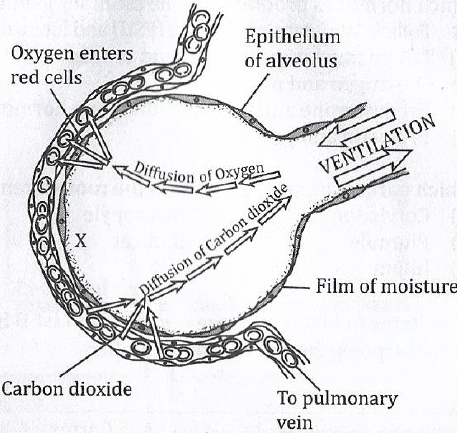 |
| Fig. 3 |
How does oxygen move from X to Y? By:
- Diffusion
- Osmosis
- Translocation
- Active transport
- Transpiration
(vii) Study the diagram below carefully (Figure 4).
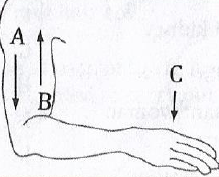 |
| Fig. 4 |
What does A represent?
- Load (hand and forearm)
- Effort (flexor of muscular upper arm)
- Fulcrum (elbow joint)
- Pulley
- 1st class lever
(viii) Which of the following substances is not a waste product in man?
- Faeces
- uric acid
- sweat
- Carbon dioxide
- urea
(ix) Which hormones produced by the pituitary gland promote ovulation?
- Follicle stimulating hormone (FSH) and lutenizing hormone (LH)
- Lutenizing hormone (LH) and progesterone
- Oestrogen and progesterone
- Progesterone and follicle stimulating hormone (FSH)
- Prolactin and progesterone
(x) Which part of the seed grows into the root system of a plant?
- Cotyledon
- mocropyle
- Plumule
- Radical
- hilum
THE UNITED REPUBLIC OF TANZANIA NATIONAL EXAMINATIONS COUNCIL OF TANZANIA CERTIFICATE OF SECONDARY EDUCATION EXAMINATION
BIOLOGY
(For Both School and Private Candidates)
Time: 3 Hours Year: 2006
SECTION A
1. For each of the items (i) - (x) choose the correct answer from among the given alternatives and write its letter beside the item number.
(i)Which of the following are the non-living parts of a cell?
- Cell wall and nucleus
- Cell wall and vacuoles
- Cytoplasm and endoplasmic reticulum
- Cytoplasm and vacuole
- Cell wall and ribosome
(ii)Which one of the following is a group of animal tissues?
- Muscles, blood, nerve and epithelia
- Eye, muscles, skin and blood
- Cardiac muscles, skin, liver and blood
- Blood, muscles, skin and kidney
- Liver, pancreas, lymph and ear
(iii)Diabetes mellitus is associated with:
- Too much insulin in the blood
- Too much glucose in the lymph
- High glycogen level in the blood
- Under secretion of insulin in the blood
- Too little glucagon in the blood
(iv)The Graph below shows changes in dry weight of a germinating seed.
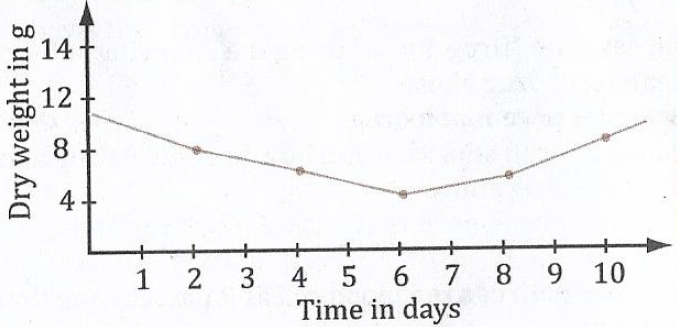 |
| Fig. 1 |
(v) The best distinction between diastolic and systolic blood pressure is that:
- Diastolic blood pressure is caused by contraction of ventricles while systolic blood pressure is caused by contraction of auricles.
- Diastolic blood pressure causes blood from contracting auricles to flow into ventricles while systolic blood pressure causes blood from contracting ventricles to flow into pulmonary artery and aorta.
- Diastolic blood pressure is the same as systolic blood pressure. Therefore there is no distinction.
- Diastolic blood pressure is lower than systolic blood pressure.
- Diastolic blood pressure is common.
(vi) Which of the following prevents surfaces of the articulating bones from being worn out by friction?
- Capsular ligament
- Synovial membrane
- Articular cartilage
- Tendon
- Synovial capsule
(vii) Figure 2 represents a of a small mammal.
| Examine Figure 2 below and answer the questions that follow: |
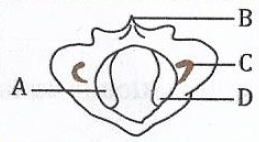 |
| Fig. 2 |
- ventral view of cervical vertebra
- anterior view of thoracic vertebra
- anterior view of atlas vertebra
- side view oflumbar vertebra
- anterior view of caudal vertebra
(viii)The structure labelled A is called:
- Vertebra arterial canal
- Posterior facet
- Neural arch
- Anterior
- Neural facet
(ix) Refer to Figure 3
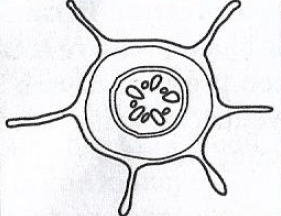 |
| Fig. 3 |
Figure 3 is a:
- Transverse section through a monocot root
- Transverse section through a dicot stem
- Transverse section through a dicot root
- Transverse section through a monocot stem
- Longitudinal section of a dicot stem
(x) Observe the punnet square below:
 |
The possible gene combination in square number 3 of Figure 4 above is:
- bcBc
- bbCc
- BbCc
- Bbcc
- bbcc
THE UNITED REPUBLIC OF TANZANIA NATIONAL EXAMINATIONS COUNCIL OF TANZANIA CERTIFICATE OF SECONDARY EDUCATION EXAMINATION
BIOLOGY
(For Both School and Private Candidates)
Time: 3 Hours Year: 2005
SECTION A
1. For each of the items (i) - (x), choose the correct answer from among the given alternatives and write its letter beside the item number.
(i) Rickets is a common feature in young children lacking one of the following vitamins:
- C
- A
- D
- B
- K
Study the diagram below (Figure 1) and answer question (ii) to (iv).
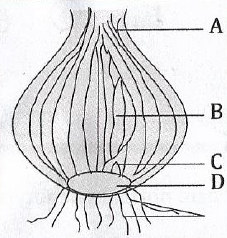 |
| Fig. 1 |
(ii)The structure which is responsible for food storage is:
- B
- A
- D
- E
- C
(iii)Vegetative propagation occurs due to the presence of structure:
- B
- A
- D
- E
- C
(iv)Figure 1 above represents a:
- rhizome
- stem tuber
- root tuber
- bulb
- stolon
(v)Which one of the following tissues is meristematic?
- cornified layer of the skin
- collenchyma
- cambium
- sclerenchyma
- xylem
(vi)The concept of good health implies . . . . . . . . health,
- sexual, physical and mental
- physical, mental and social
- mental, sexual and physical
- physical, mental and family
- reproductive, social and family
(vii) Figure 2 shows a section of a villus.
Which part is a lymphatic vessel?
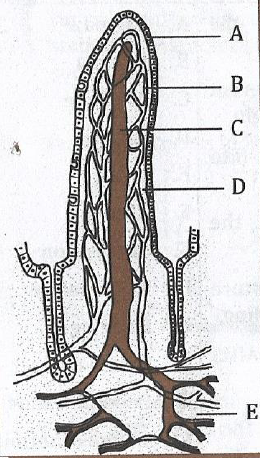 |
| Fig. 2 |
(viii) When red flowered pea plants crossed with white flowered pea plants, all the Fl generation had pink flowers. This is an example of:
- Crossing over
- Mutation
- Incomplete dominance
- Recessiveness
- Inbreeding
(ix)The Figure below shows a section of a root tip.
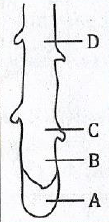 |
| Fig. 3 |
Which part of the root tip undergoes rapid cell division?
- A
- B
- C
- D
- A and B
(x)Study the following sequence of organisms:
Grass → Rabbit → Wolves → Fleas
The sequence is an example of:
- a food web
- a food chain
- an ecosystem
- a pyramid
- a community
THE UNITED REPUBLIC OF TANZANIA NATIONAL EXAMINATIONS COUNCIL OF TANZANIA CERTIFICATE OF SECONDARY EDUCATION EXAMINATION
BIOLOGY
(For Both School and Private Candidates)
Time: 3 Hours Year: 2004
SECTION A
1. For each of the items (i) — (x) choose the correct answers from among the given alternatives and write its letter beside the item number.
(i) Cell walls:
- give rigidity to plant and animal cells
- are made up of a layer of pectin
- are composed mainly of cellulose
- are a product of middle lamella
- surround all types of cells.
(ii) Green plants are known as producers because they:
- produce chlorophyll in chloroplasts
- produce green leaves
- contain fruits and seeds
- grow in fertile soil
- make food from simple stibstances
(iii)The Figure below represents:
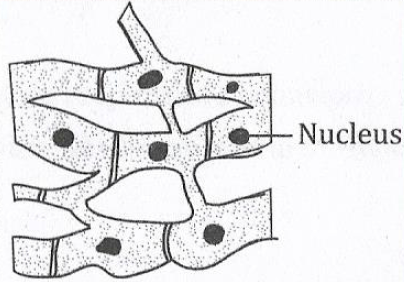 |
| Fig. 1 |
- cardiac muscle
- skeletal muscle
- involuntary muscle
- mycelium
- nervous tissue
(iv) A human ovary produces ova and the following hormones:
- Oestrogen and testosterone
- Progesterone and testosterone
- Follicle stimulating hormone (F.S.H) and progesterone.
- Oestrogen and progesterone
- F.S.H and Oestrogen.
(v)The following is a list of diseases caused by bacteria:
- Pneumonia, elephantiasis, cholera
- Pneumonia, malaria, cholera
- Bilharzias, cholera, pneumonia
- Tuberculosis, pneumonia, small pox
- Tuberculosis, pneumonia, cholera
(vi)Which of the following parts of the germinating seed is an embryonic shoot?
- Hypocotyls
- Radical
- Plumule
- Cotyledon
- Endosperm
(vii) A biologist discovered a new cell in a culture. The new cell had a distinct cell wall but it did not have a definite nucleus. The cell is most likely to be:
- Fungi
- Prokaryote
- Protozoa
- Virus
- Eukaryote
(viii)Oxygen debt occurs when:
- Too much carbon dioxide is present in the body.
- The rate of respiration exceeds that of photosynthesis in green plants.
- Alcohol is formed in tissues.
- There is insufficient oxygen in the muscle tissues during strenuous exercise.
- There is insufficient lactic acid in muscle tissues.
(ix) If the magnifying power of the eyepiece lens of the compound microscope is x10 and that of the high power objective lens is x40, what is the magnification of a specimen under observation?
- x10
- x400
- x50
- x40
- x5000
(x) What type of germination is presented by the figure below?
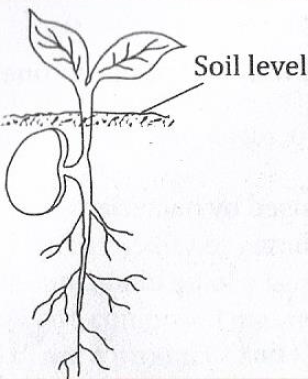
- Epigeal
- Hypogeal
- Tap-root
- Hypocotyl
- Apical
THE UNITED REPUBLIC OF TANZANIA NATIONAL EXAMINATIONS COUNCIL OF TANZANIA CERTIFICATE OF SECONDARY EDUCATION EXAMINATION
BIOLOGY
(For Both School and Private Candidates)
Time: 3 Hours Year: 2003
SECTION A
1. For each of the items (i) — (x) choose the correct answer from the given alternatives and write its letter beside the item number.
(i)The release of an egg cell from the ovary is known as:
- Evolution
- Menstruation
- Ovulation
- Ecdysis
- Parturition
(ii) Maintenance of a constant internal environment means:
- Osmoregulation
- Excretion
- Re-absorption
- Homeostasis
- Secretion
(iii) If a parent cell has 12 chromosomes, how many chromosomes will be in the daughter cells formed after meiosis?
- Six (6)
- Twelve (12)
- Eighteen (18)
- Twenty(20)
- Thirty six (36)
(iv)Viruses are considered to be non-living because:
- They are only active in the contents of a living cell
- They have true nuclei
- The body is covered by a cell wall
- They are single-cell eukaryotic organisms.
- They are multicellular organisms.
(v)Study Fig. 1 below carefully, and answer the question below. The aim of the experiment was to investigate the
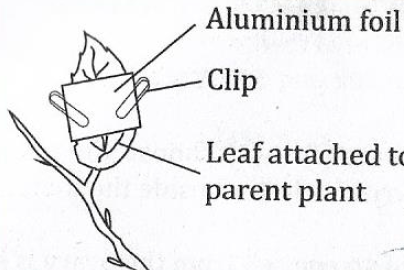 |
| Figure 1 |
- Use of aluminium foil on plant leaves
- Necessity of chlorophyll for photosynthesis
- Necessity of light for photosynthesis
- Presence of starch in the leaf
- Importance of water in photosynthesis
(vi) Which of the following joints allow movements in one plane only?
- Ball and socket
- Gliding
- Hinge
- Immovable
- Gliding and immovable
(vii) The stamen of a flower consists of:
- Stigma and ovary
- Anther and stamen
- Filament and ovary
- Anther and filament
- Ovary and anther
(viii) An experiment:
- always guarantees scientific conclusion
- should always be carried out in the laboratory
- suggests a hypothesis
- is valid only when it is carried out with a control
- must start with a hypothesis and end up with the identification of a problem.
(ix) In which of the following tissues can rapid mitotic cell division be seen?
- Nerve
- Heart
- Embryonic
- Muscle
- Epidermal
(x) Which of the following series of activities take place together when focusing distant objects?
- Ciliary muscles relax and the lens becomes thin
- Ciliary muscles contract and the lens becomes thin
- Ciliary muscles contract and the lens becomes thick
- Ciliary muscles relax and the lens becomes thick
- Ciliary muscles relax and pull the lens into its normal round shape.
VIEW MARKING SCHEME

 For Call,Sms&WhatsApp: 255769929722 / 255754805256
For Call,Sms&WhatsApp: 255769929722 / 255754805256
 For Call,Sms&WhatsApp: 255769929722 / 255754805256
For Call,Sms&WhatsApp: 255769929722 / 255754805256





